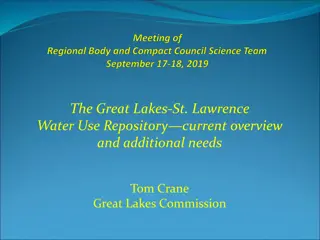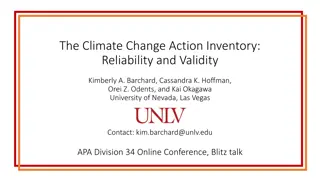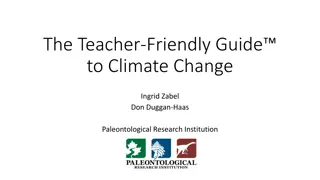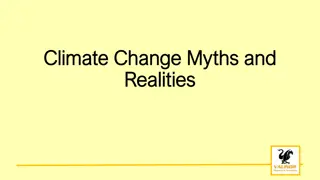Understanding the Importance of Lakes in Climate Change Research
Lakes play a crucial role as integrators of catchment change and sentinels of climate change. With millions of lakes worldwide, they provide essential ecosystem services and have high cultural value. The Lake ECVs project aims to establish a consistent time-series of lake data using various instruments to monitor variables such as water extent, ice cover, temperature, and reflectance. Innovations in satellite sensor usage and data consistency are key focus areas to improve understanding and address gaps in lake monitoring.
Download Presentation

Please find below an Image/Link to download the presentation.
The content on the website is provided AS IS for your information and personal use only. It may not be sold, licensed, or shared on other websites without obtaining consent from the author. Download presentation by click this link. If you encounter any issues during the download, it is possible that the publisher has removed the file from their server.
E N D
Presentation Transcript
Lake ECVs Stefan Simis (PML), Jean-Francois Cretaux (LEGOS), Claudia Giardino (CNR), Chris Merchant (Reading), Herve Yesou (SERTIT), Claude Duguay (H2O Geomatics) ESA UNCLASSIFIED - For Official Use ESA UNCLASSIFIED - For Official Use ESA | 01/01/2016 | Slide 1
Lakes and climate Study Lakes are integrators of catchment change Lakes are sentinels of climate change Protect Lakes are disappearing* Lakes are degrading** 117 million lakes Verpoorter et al. 2014 GRL Value Lakes provide unique ecosystem services Lakes have high cultural value ESA UNCLASSIFIED - For Official Use ESA | 01/01/2016 | Slide 2
Target groups for CCI Lakes - Climate modelers: substitute observations for a number of general assumptions in widely used box models (e.g. Flake) Lake scientists addressing local / regional / global change (land use, fisheries, aquaculture, limnology, hydrology, ecology, ...) Catchment modelers Lake state/quality monitoring stakeholders - - - ESA UNCLASSIFIED - For Official Use ESA | 01/01/2016 | Slide 3
Project objectives Provide the first consistent, longest attainable time-series of the largest possible number of lakes covering all variables under the Lakes ECV At least 21 instruments considered: - - - - Lake Water Extent & Lake Level Lake Ice Cover Lake Surface Water Temperature Lake Surface Water Reflectance Jason-3, SRAL A/B, SWOT (+ new methodologies) AVHRR, MODIS A/T, VIIRS, OLCI A/B, C-SAR A/B ATSR2, AATSR, Metop-A/B, SLSTR A/B, ATSR-1 MERIS, OLCI A/B, MODIS A, VIIRS, SeaWIFS Consistency: Lake targets, masks/boundaries, output formats (projection, resolutions), rule- based product checks Limitations: Observations are not synchronous, revisiting times differ, continuity issues and generational increase in satellite capability ESA UNCLASSIFIED - For Official Use ESA | 01/01/2016 | Slide 4
Timeline for Innovations and Outputs Innovations per production team focus on - Adding satellite sensors into data set - Improving uncertainty characterization 2019 2020 2021 CM UG CM UG KO CM UG WS User requirements updates User consultation Innovations for Lakes ECV consistency focus on - Optimizing common output grids - Identifying prominent data gaps - Common and broad climatic coverage V2 M27 V1 M12 Extended coverage, Improved uncertainty characterization for each variable, multiple sensors added From current state of the art to a common format for a common time period and set of lakes* Input (priorities) from CRG, CMUG and other user groups essential for v1 -> v2 evolution 5 CRG use cases ESA UNCLASSIFIED - For Official Use ESA | 01/01/2016 | Slide 5
Climate Research Group use cases Five use cases: Analysis of ECVs for lakes around the Tibetan Plateau (Temperature, Ice Cover, Water Level) Analysis and interpretation of ECVs for large lakes -> SDG 6 (Colour, Temperature over a climatic gradient) Exploiting ECVs in Long Term Ecosystem Research (integrating in situ and satellite data records) Brownification in Scandinavian lakes (Colour, Level, Ice on/off) Consistency of ECVs in the Danube river-lake-lagoon (Colour-derived biogeochemical products, Temperature) ESA UNCLASSIFIED - For Official Use ESA | 01/01/2016 | Slide 6
Feedback on CMUG session 1. Feedback from CMUG session (on the Monday afternoon) CMUG WP3 Quality Assessment Task 3.7 on Lakes: spatial and temporal consistency analysis Focus on Lake Surface Water Temperature - Lake Ice Cover, Extent/Level (Volume) and Lake Colour may help explain variability in existing lake models (such as Flake and HYPE) and bidirectional effects on Land Surface Temperature - Opportunity to substitute observations for coarse climatologies (e.g. Flake) Need feedback in first project phase on desired spatial/temporal resolution, regions of interest (CMUG WP 3.7) and accuracy requirements. Start this at/from project kick-off. ESA UNCLASSIFIED - For Official Use ESA | 01/01/2016 | Slide 7
Summary questions Will your User Requirements be consistent with the needs of the Climate Research Groups (CRGs), CMUG needs, and GCOS requirements, including source traceability? Inconsistencies in GCOS requirements will be addressed. Use cases were designed to test the products and update user requirements. How will your product specifications develop to meet the needs of your individual Climate Research Group, how will the CRGs use the proposed products in their applications? This is the first project to produce multi-variable satellite data records for lake scientists so intensive dialogue is foreseen. CRG includes both EO and non-EO experts. ESA UNCLASSIFIED - For Official Use ESA | 01/01/2016 | Slide 8
Summary questions How will you address the integrated perspective for consistency between the ECVs, including identification of gaps? Lakes ECV presents an internal challenge to provide consistency between five (plus derived) variables. Links with Glaciers, Biomass, Land Cover identified. Examples: common output grids, land/water masks are already being considered. How will you deal with uncertainties in products? Magnitude and error correlation structure of at least dominant effects will be considered for each variable. Depending on the variable either per pixel or per lake (e.g. LWL) uncertainties will be included with products. Beware of severe in situ data gaps! ESA UNCLASSIFIED - For Official Use ESA | 01/01/2016 | Slide 9
Summary questions What data are you producing, and when? V1: M12 (end 2019) all variables, limited (10s-100s) common lake coverage v2: M27 (spring 2021) extended coverage (1000s) and harmonization What are your data needs for ECMWF reanalysis data? This has not been discussed yet How will you know if your CRG work is complementary with CMUG research? We expect that inland water focus may yet be limited in CMUG and we are here to help. What CCI-relevant meetings do you plan to attend over the next 12 months? Collocation, Living Planet, ASLO, CCI Lakes User meeting in M12 (Jan 2020?), "Parameterization of Lakes in NWP and Climate Modelling , Toulouse 21-25 Oct 2019. ESA UNCLASSIFIED - For Official Use ESA | 01/01/2016 | Slide 10
ESA UNCLASSIFIED - For Official Use ESA | 01/01/2016 | Slide 11























